Temporal and Spatial Analysis of Pedestrian Count Data for Thermal Environmental Planning in Street Canyons
Abstract
1. Introduction
2. Materials and Methods
2.1. Study Area
2.2. Analysis Data
2.3. Analysis Method
2.4. Methods for Developing Thermal Environment Index Distribution
3. Results
3.1. Principal Component Analysis and Cluster Classification Results
3.2. Typical Examples of Cluster Analysis Results
3.3. Percentage of Clusters
3.4. Calculation Results of SET* Distribution
- -
- Cluster 1 had higher temperatures in the morning and was distributed on the west side of the north–south road.
- -
- Cluster 2 had higher temperatures in the afternoon and was distributed on the east side of the north–south road.
- -
- Cluster 3 had lower temperatures throughout the day and was distributed on the south side of the east–west road.
- -
- Cluster 5 had higher temperatures throughout the day and was distributed on the north side of the east–west road and on the wider road.
4. Discussion
4.1. Relationship Between Pedestrian Count Data Analysis and Thermal Environment Analysis
4.2. Temporal Characteristics of Pedestrian Count Data and Thermal Environmental Indices
4.3. Spatial Characteristics of Pedestrian Count Data and Thermal Environmental Indices
4.4. Limitations and Relevance of This Study
- (1)
- high temperatures in the morning on the west sidewalk of the north–south road,
- (2)
- high temperatures in the afternoon on the east sidewalk of the north–south road,
- (3)
- low temperatures throughout the day on the south sidewalk of the east–west road,
- (4)
- high temperatures throughout the day on the north sidewalk of the east–west road and on sidewalks along wide roads.
5. Conclusions
Author Contributions
Funding
Institutional Review Board Statement
Informed Consent Statement
Data Availability Statement
Acknowledgments
Conflicts of Interest
References
- Kearl, Z.; Vogel, J. Urban extreme heat, climate change, and saving lives: Lessons from Washington state. Urban Clim. 2023, 47, 101392. [Google Scholar] [CrossRef]
- Heat Illness Prevention Information. Available online: https://www.wbgt.env.go.jp/en/ (accessed on 26 March 2025).
- Kenny, G.P.; Yardley, J.; Brown, C.; Sigal, R.J.; Jay, O. Heat stress in older individuals and patients with common chronic diseases. Can. Med. Assoc. J. 2010, 182, 1053–1060. [Google Scholar] [CrossRef] [PubMed]
- Vandentorren, S.; Bretin, P.; Zeghnoun, A.; Mandereau-Bruno, L.; Croisier, A.; Cochet, C.; Ribéron, J.; Siberan, L.; Declercq, B.; Ledrans, M. August 2003 heat wave in France: Risk factors for death of elderly people living at home. Eur. J. Public Health 2006, 16, 583–591. [Google Scholar] [CrossRef] [PubMed]
- Nayak, S.G.; Shrestha, S.; Sheridan, S.C.; Hsu, W.H.; Muscatiello, N.A.; Pantea, C.I.; Ross, Z.; Kinney, P.L.; Zdeb, M.; Hwang, S.A.; et al. Accessibility of cooling centers to heat-vulnerable populations in New York state. J. Transp. Health 2019, 14, 100563. [Google Scholar] [CrossRef] [PubMed]
- Lee, K.; Chae, Y. Analysis of socioeconomic disparities and accessibility to cooling centers using travel time of 100 m × 100 m grids in South Korea. Urban Clim. 2021, 36, 100762. [Google Scholar] [CrossRef]
- Heat Countermeasure Guideline in the City. Available online: https://www.wbgt.env.go.jp/pdf/city_gline/city_guideline_full.pdf (accessed on 26 March 2025).
- Nikolopoulou, M.; Lykoudis, S. Thermal comfort in outdoor urban spaces: Analysis across different European countries. Build. Environ. 2006, 41, 1455–1470. [Google Scholar] [CrossRef]
- Johansson, E. Influence of urban geometry on outdoor thermal comfort in a hot dry climate: A study in Fez, Morocco. Build. Environ. 2006, 41, 1326–1338. [Google Scholar] [CrossRef]
- Johansson, E.; Emmanuel, R. The influence of urban design on outdoor thermal comfort in the hot, humid city of Colombo, Sri Lanka. Int. J. Biometeorol. 2006, 51, 119–133. [Google Scholar] [CrossRef] [PubMed]
- Ali-Toudert, F.; Mayer, H. Numerical study on the effects of aspect ratio and orientation of an urban street canyon on outdoor thermal comfort in hot and dry climate. Build. Environ. 2006, 41, 94–108. [Google Scholar] [CrossRef]
- Ali-Toudert, F.; Mayer, H. Effects of asymmetry, galleries, overhanging facades and vegetation on thermal comfort in urban street canyons. Sol. Energy 2007, 81, 742–754. [Google Scholar] [CrossRef]
- Ali-Toudert, F.; Mayer, H. Thermal comfort in an east–west oriented street canyon in Freiburg (Germany) under hot summer conditions. Theor. Appl. Climatol. 2007, 87, 223–237. [Google Scholar] [CrossRef]
- Emmanuel, R.; Rosenlund, H.; Johansson, E. Urban shading—A design option for the tropics? A study in Colombo, Sri Lanka. Int. J. Climatol. 2007, 27, 1995–2004. [Google Scholar] [CrossRef]
- Hwang, R.L.; Lin, T.P.; Matzarakis, A. Seasonal effects of urban street shading on long-term outdoor thermal comfort. Build. Environ. 2011, 46, 863–870. [Google Scholar] [CrossRef]
- Takebayashi, H.; Moriyama, M. Relationships between the properties of an urban street canyon and its radiant environment: Introduction of appropriate urban heat island mitigation technologies. Sol. Energy 2012, 86, 2255–2262. [Google Scholar] [CrossRef]
- Lindberg, F.; Thorsson, S.; Rayner, D.; Lau, K. The impact of urban planning strategies on heat stress in a climate-change perspective. Sustain. Cities Soc. 2016, 25, 1–12. [Google Scholar] [CrossRef]
- Hirose, T.; Imura, S.; Kinuta, Y.; Yabe, T. Understanding Tourists’ Activity through Analyzing Smartphone Data. In IBS Annual Report; The Institute of Behavioral Science: Tokyo, Japan, 2019; pp. 43–50. [Google Scholar]
- Imai, R.; Fukada, M.; Shigetaka, K.; Yabe, T.; Makimura, K.; Adachi, R. Feasibility study on applicability of multi-tail data using combinational analysis in urban transportation planning. In Proceedings of the 47th Annual Conference on Civil Engineering and Planning, Hiroshima, Japan, 1–2 June 2013; pp. 1–9. [Google Scholar]
- Kumakura, E.; Ashie, Y.; Ueno, T. Research on the Heat Risk Related to Urban Heat Islands, Part 2: Analysis of Population Flow Data, Summaries of Technical Papers of Annual Meeting Architectural Institute of Japan; Architectural Institute of Japan: Tokyo, Japan, 2022; Volume D-1, pp. 2125–2126. [Google Scholar]
- Sensors & Work. Available online: https://www.sensorsandworks.com (accessed on 26 March 2025).
- Yanai, H. Handbook of Multivariate Analysis; Gendai-Sugakusha: Kyoto, Japan, 1986; pp. 70–80+224–242. [Google Scholar]
- Takebayashi, H. Thermal environment design of outdoor spaces by examining redevelopment buildings opposite central Osaka station. Climate 2019, 7, 143. [Google Scholar] [CrossRef]
- Takebayashi, H.; Okubo, M.; Danno, H. Thermal environment map in street canyon for implementing extreme high temperature measures. Atmosphere 2020, 11, 550. [Google Scholar] [CrossRef]
- Takebayashi, H.; Danno, H.; Tozawa, U. Study on strategies to implement adaptation measures for extreme high temperatures into the street canyon. Atmosphere 2022, 13, 946. [Google Scholar] [CrossRef]
- Watanabe, S.; Ishii, J. Effect of outdoor thermal environment on pedestrians’ behavior selecting a shaded area in a humid subtropical region. Build. Environ. 2016, 95, 32–41. [Google Scholar] [CrossRef]
- Zhang, X.; Ludwig, F. Shade for pedestrians: A novel approach to calculate the spatio-temporal shade benefits of street trees considering pedestrian flow. Build. Environ. 2025, 272, 112662. [Google Scholar] [CrossRef]

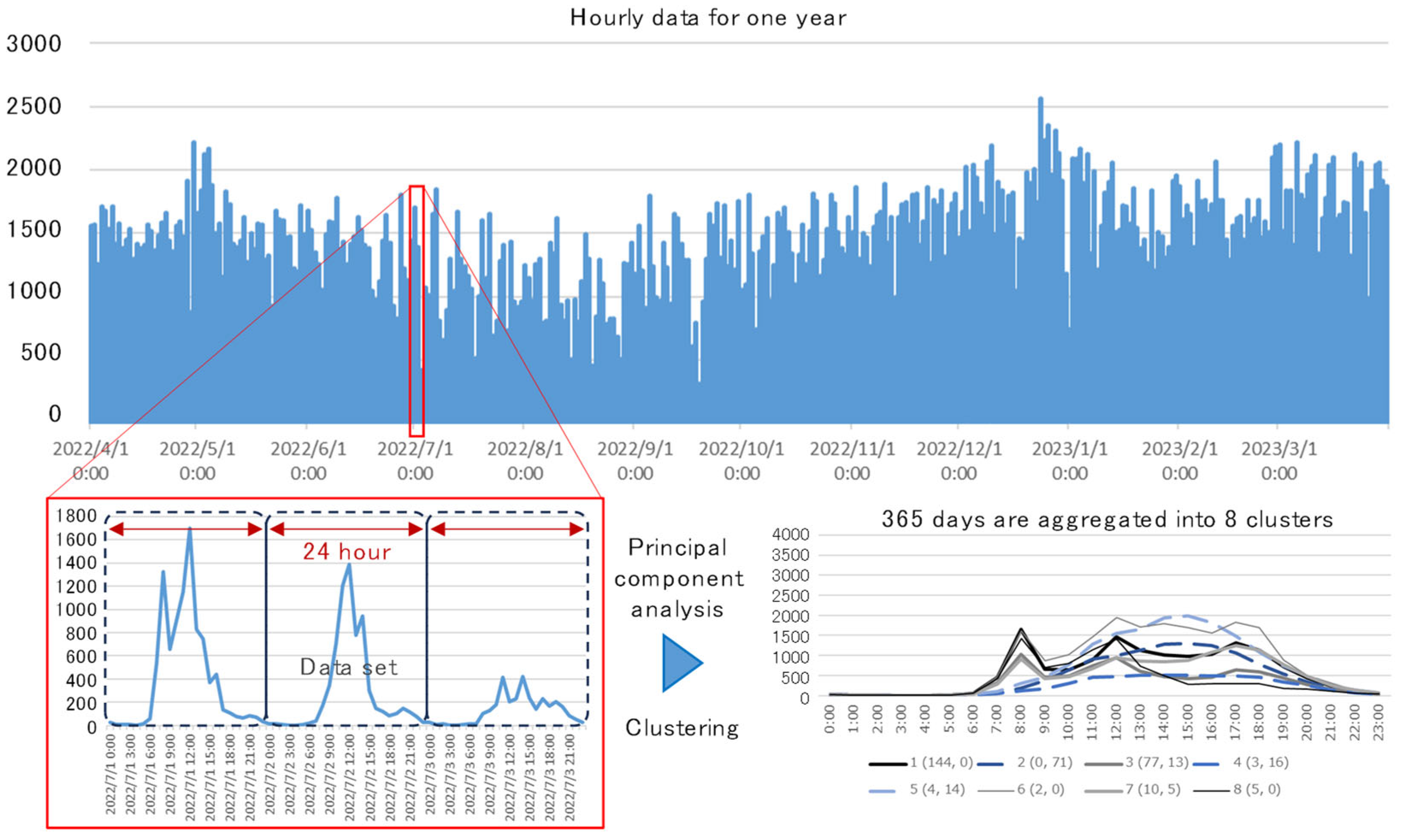



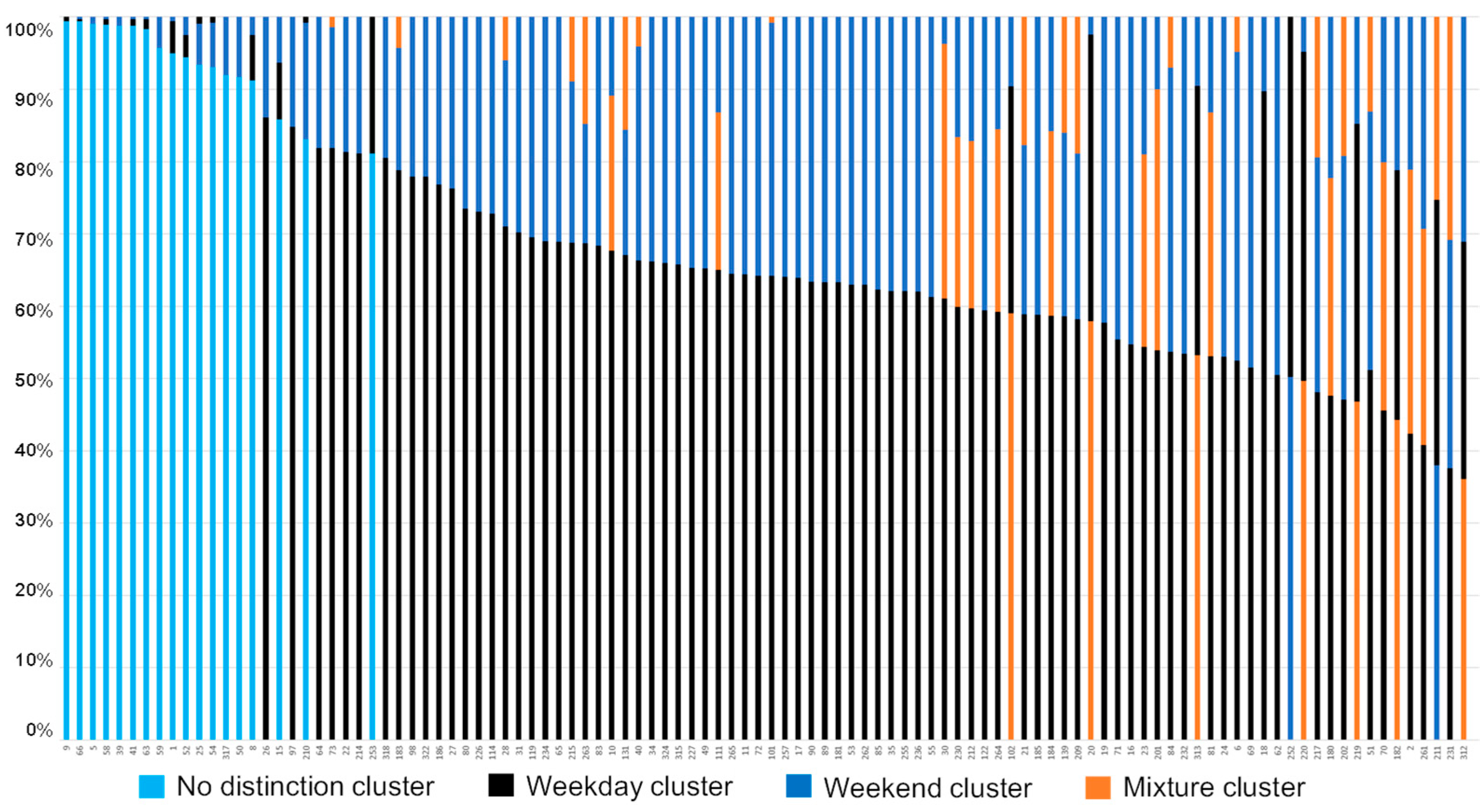
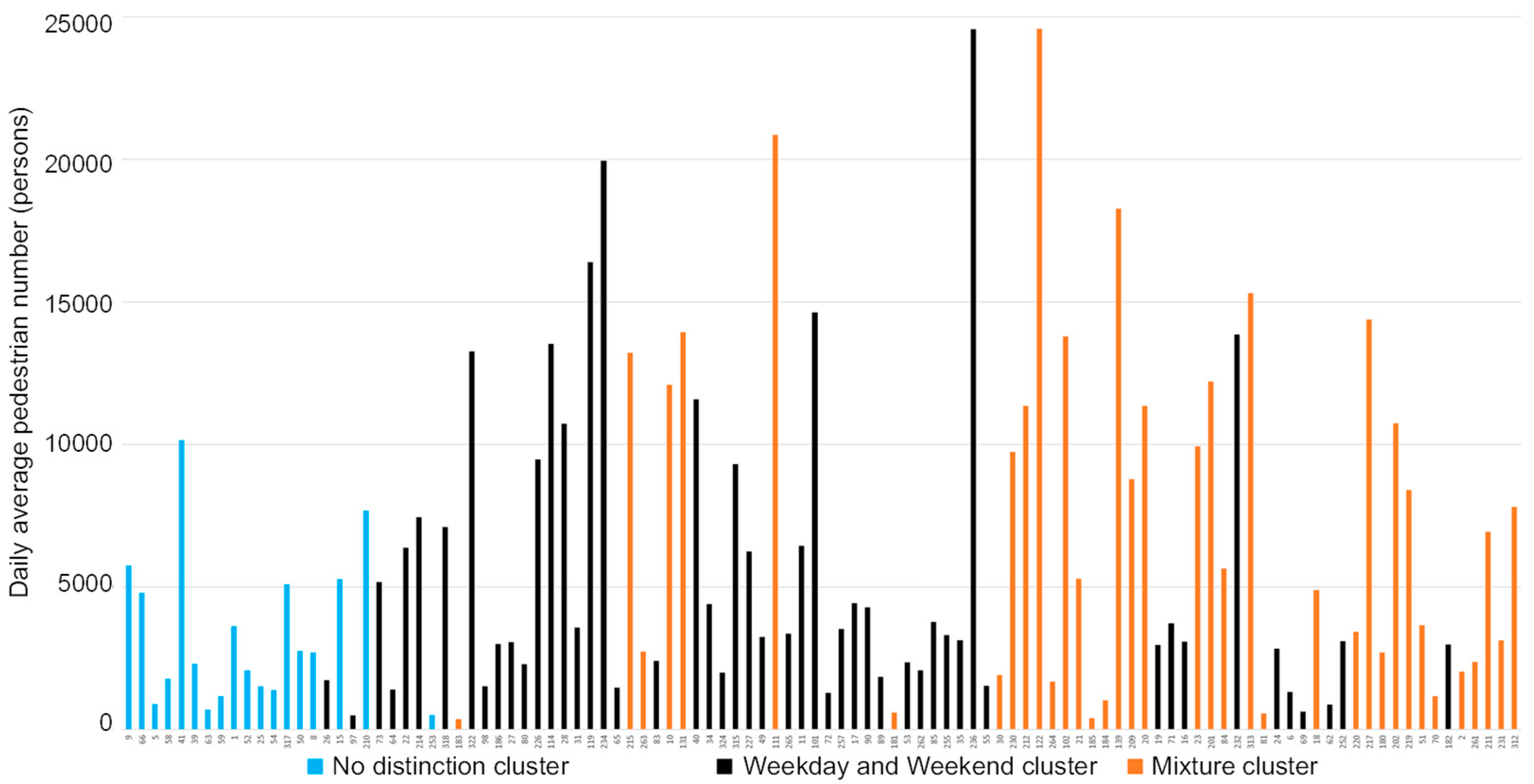

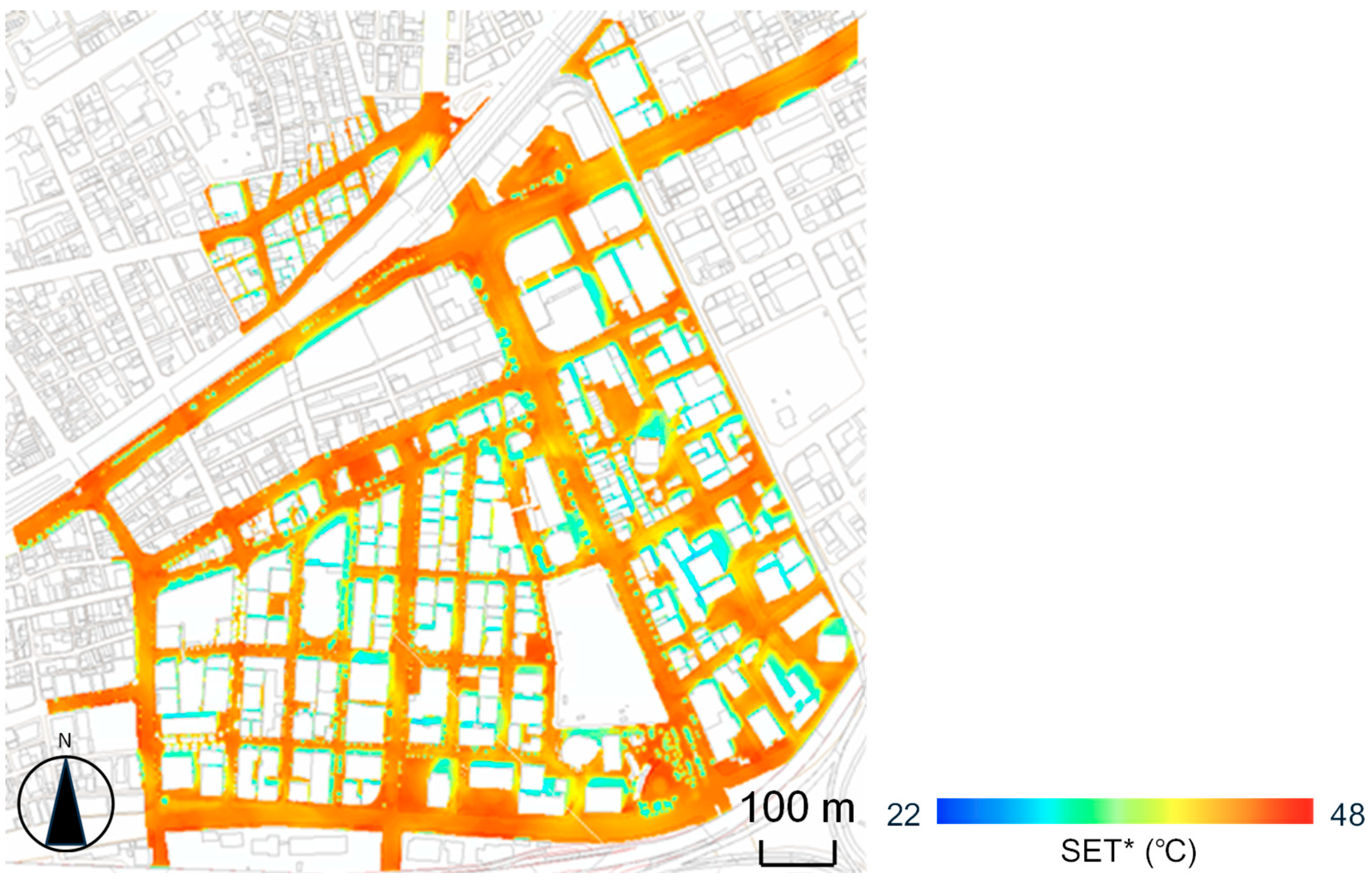

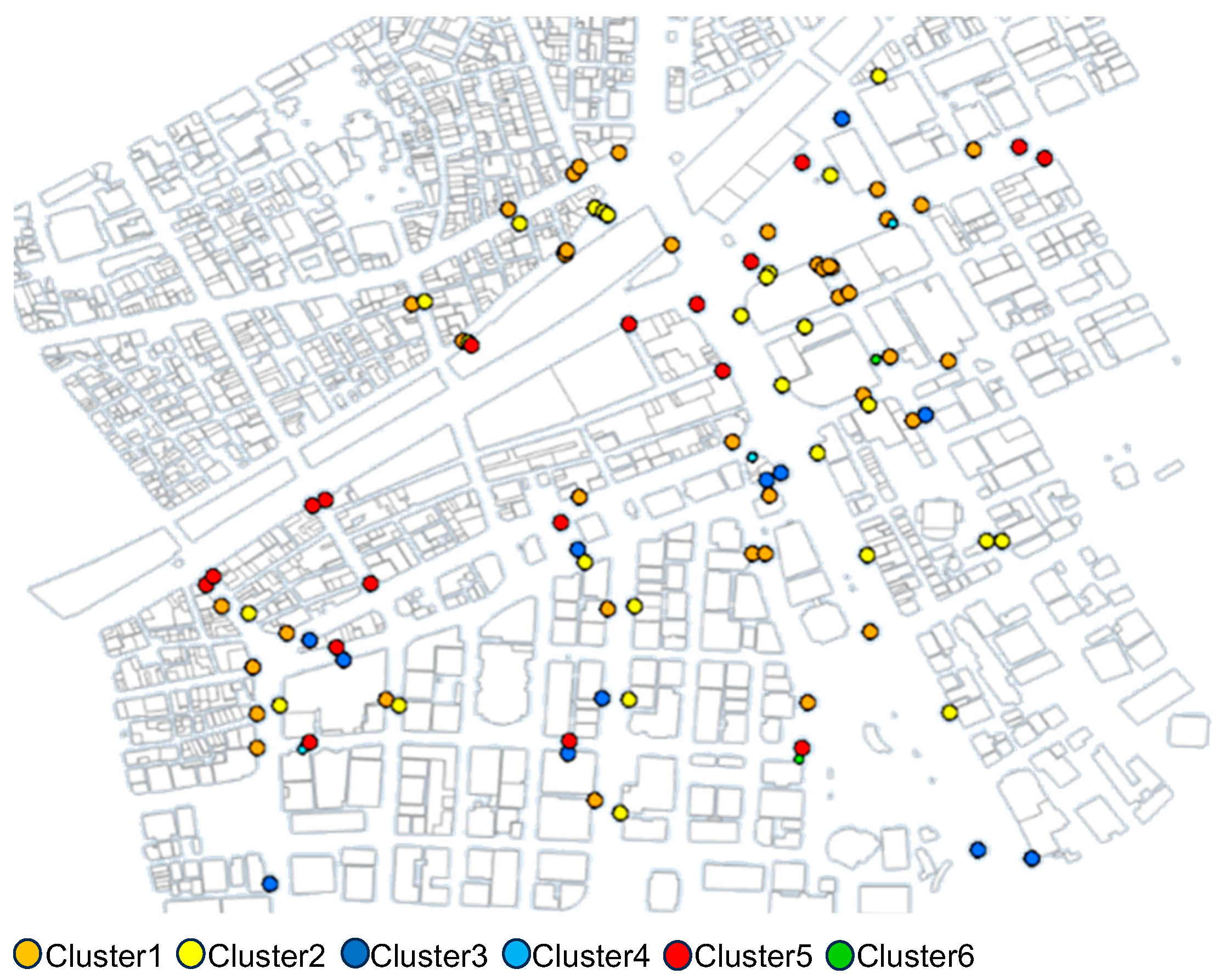


| Device Name | Function | Detection Distance |
|---|---|---|
| Sign TYPE-B | Single-axis movement direction detection | 3 m to 5 m |
Disclaimer/Publisher’s Note: The statements, opinions and data contained in all publications are solely those of the individual author(s) and contributor(s) and not of MDPI and/or the editor(s). MDPI and/or the editor(s) disclaim responsibility for any injury to people or property resulting from any ideas, methods, instructions or products referred to in the content. |
© 2025 by the authors. Licensee MDPI, Basel, Switzerland. This article is an open access article distributed under the terms and conditions of the Creative Commons Attribution (CC BY) license (https://creativecommons.org/licenses/by/4.0/).
Share and Cite
Takebayashi, H.; Hayakawa, T. Temporal and Spatial Analysis of Pedestrian Count Data for Thermal Environmental Planning in Street Canyons. Atmosphere 2025, 16, 504. https://doi.org/10.3390/atmos16050504
Takebayashi H, Hayakawa T. Temporal and Spatial Analysis of Pedestrian Count Data for Thermal Environmental Planning in Street Canyons. Atmosphere. 2025; 16(5):504. https://doi.org/10.3390/atmos16050504
Chicago/Turabian StyleTakebayashi, Hideki, and Taichi Hayakawa. 2025. "Temporal and Spatial Analysis of Pedestrian Count Data for Thermal Environmental Planning in Street Canyons" Atmosphere 16, no. 5: 504. https://doi.org/10.3390/atmos16050504
APA StyleTakebayashi, H., & Hayakawa, T. (2025). Temporal and Spatial Analysis of Pedestrian Count Data for Thermal Environmental Planning in Street Canyons. Atmosphere, 16(5), 504. https://doi.org/10.3390/atmos16050504








